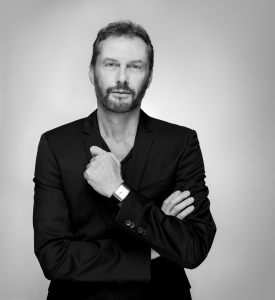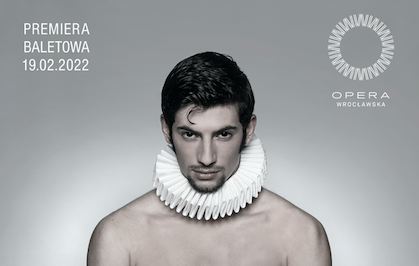Kim jest Don Juan? – opowiada Giorgio Madia

Fine Art photography by Yan Revazov
Reżyser i choreograf Giorgio Madia opowiada nam o swojej wizji Don Juana, nad którą będzie pracował z naszym zespołem od początku lutego aż do premiery w 19 lutego.
Rozwiejmy wszelkie wątpliwości: jak właściwie wymawiać tytuł spektaklu ?
Poprawna wymowa według mnie to ‘don huan’, ponieważ oryginalna historia wyszła spod pióra Hiszpana, dramaturga Tirso de Moline. Mamy również Don Giovanniego i jego bardziej znane wersje jak ta autorstwa Lorenza Da Pontego. Ale moja wersja to ‘don huan’.
Kim jest ten tytułowy Don Juan?
To wciąż otwarta kwestia, która jest przedmiotem wielu opracowań i opowiadań. W moim balecie, kim on właściwie jest można dowiedzieć się dopiero pod koniec spektaklu. Na pewno jest egoistą, który czerpie siłę z dominacji nad innymi postaciami i ogólnie rzecz biorąc, nad życiem. Zostaje ukarany, bo jego czyny stoją w sprzeczności z nauczaniem Kościoła. Z tego powodu, w mojej produkcji towarzyszy mu postać, która jest kimś w rodzaju jego alter ego, pokrewną duszą, która przyjmuje postać diabła. To wskazówka dotycząca jego osobowości i moja interpretacja tej postaci. Dramaturgia spektaklu lepiej wyjaśni, kim tak naprawdę jest Don Juan. A może będzie to pytanie do publiczności pod koniec spektaklu…
Jak opowiadać na nowo postać Don Juana, cynicznego łowcy kobiecych serc, wyrafinowanego kochanka, a jednocześnie manipulanta i egoisty? Artyści różnych epok robili to na swoje sposoby.
Moje podejście do Don Juana oparte jest na poszukiwaniu, badaniu jego osobowości. Doceniam go nie tylko z mentalnego punktu widzenia, ale również z estetycznego. Pociąga go piękno, erotyka, seksualność – to są stałe części jego języka. Pokazuję to wszystko w moim balecie, w którym z fascynacją mówi o seksualności i zmysłowości, jest w tym nuta deprawacji. Pojawiają się w tym balecie poważne elementy, które nie są dla młodej publiczności. zdecydowanie jest to spektakl dla widzów dorosłych.
Doceniam złożoność tego baletu, jego dramaturgię, w której interesujące jest to, że Don Juan nie jest kimś, kto kocha kobiety – on kocha ich podbój. Wyróżnia się więc już z punktu psychologicznego. Kolejny aspekt, który wziąłem pod uwagę, to zmysłowość. W balecie, nie ma lepszego sposobu na wyrażenie uroku uwodzenia niż fizyczność. Ważna jest też estetyka – chciałem mieć na nią klasyczne spojrzenie łączące elementy współczesne i retro. Widzimy to w kostiumach z epoki, które jednak nie są dosłowne, służą raczej interpretacji.
Balet to afirmacja ludzkiego ciała – na czym skupiasz się, tworząc choreografię i na co chcesz skierować uwagę widzów?
Oczywiście w Don Juanie niezwykle ważny jest czynnik estetyczny, ponieważ taniec jest sztuką wizualną, ale według mnie strona psychologiczna jest jeszcze bardziej interesująca i to na nią chciałbym zwrócić uwagę publiczności. To opowieść w formie farsy baletowej, w której ciało pełni rolę komentatora, podobnie jak w commedia dell’arte, która była pierwszą narracją mitu o Don Juanie, jeszcze zanim Tirso da Molina przelał go na papier.
Don Juan ,,tańczy” z muzyką Christopha Willibalda Glucka – jakie żywioły połączysz ze sobą w tańcu i muzyce?
Gluck stworzył utwór Don Juan trwający około 20 minut – nie miał ambicji opowiedzenia całej historii. Operacja, którą wykonałem, polegała na rozszerzeniu tego baletu na cały wieczór, co osiągnąłem dzięki dołączeniu innych kompozycji tego fantastycznego kompozytora. Usłyszymy je na żywo w wykonaniu cudownej Orkiestry Opery Wrocławskiej. To właśnie pomogło mi znaleźć inspirację dla tej historii. Muzyka i atmosfera tworzą ten balet.
Dlatego warto zobaczyć Don Juana?
Myślę, że mój Don Juan wyróżnia się oryginalnością. Wierzę, że ktoś, kto przyjdzie zobaczyć ten balet, będzie zaskoczony jego różnorodnością i odstępstwem od tego, co nazywamy standardowym baletem. Oczywiście ostatecznym celem widowiska jest dostarczenie publiczności rozrywki. Osiągnąć to możemy za pomocą środków wizualnych oraz dzięki wirtuozerii muzycznej. Don Juan to balet zmysłowy i erotyczny, ma swojego konkretnego adresata, który tego oczekuje i chce dobrze się bawić. Ponieważ jest to balet farsowy, ma w sobie również momenty ironii i uduchowienia, jest nawet kilka bardzo dramatycznych momentów. Ta historia nie jest lekką opowieścią, widzimy w niej też zestawienie ogromnych kontrastów pomiędzy świętością, religią a deprawacją. To silne w swoim wyrazie aspekty, ich wartość dostrzegamy właśnie w tych kontrastach.
Czy będą momenty, w których mogą pojawić się rumieńce na twarzy?
Są momenty, które mogą być niewygodne. Jeżeli nie wyjaśnimy tych niepokojących stron opowieści, nie opiszemy jej we właściwy sposób. Nie można tego opowiedzieć lekko, bo to nie jest lekka historia. Ciężar wynika z pojemności gatunkowej: znajdzie się tam miejsce na komedię, dramat, pojawią się elementy zarówno ironiczne, jak i zmysłowe. Taniec to uniwersalny język, a Don Juana w słowa ubierze Opera Wrocławska. Nie mogę się tego doczekać!
Rozmawiała Patrycja Czerwińska
Director and choreographer Giorgia Madia, tells us about his vision of Don Juan, which he will be working on with our company from the beginning of February until the premiere on 19 February.
Let’s dispel all doubts: how do you actually pronounce the title of the performance ?
The correct pronunciation in my opinion is ‘don huan’, because the original story was written by the Spanish playwright Tirso de Moline. We also have Don Giovanni and its more famous versions like the one by Lorenzo Da Ponte. But my version is ‘don huan’.
Who is this titular Don Juan?
This is still an open question which is the subject of more than a few studies and stories. Who he actually is, in my ballet you can only find out at the end of the performance. He is certainly an egotist who draws strength from his domination over other characters and life in general. He is punished because his actions contradict the teaching of the Church. For this reason, in my production he is accompanied by a character who is something like his alter ego, a kindred soul who takes the form of the devil. This is a clue to his personality and my interpretation of this character. The dramaturgy of the play will better explain who Don Juan really is. Or maybe it will be a question for the audience at the end of the play…
How do we re-tell the story of Don Juan, the cynical hunter of women’s hearts, the sophisticated lover, and the manipulator and egoist at the same time? Artists of various eras have done it in their own ways.
My approach to Don Juan is based on a search, an exploration of his personality. I appreciate him not only from a mental point of view, but also from an aesthetic one. He is attracted to beauty, eroticism, sexuality – these are constant parts of his language. I show all this in my ballet, in which he speaks with fascination about sexuality and sensuality, there is a note of depravity in it. There are serious elements in this ballet, which are not for the young audience. it is definitely a performance for an adult audience.
I appreciate the complexity of this ballet, its drama, in which it is interesting that Don Juan is not someone who loves women – he loves to conquer them. So it stands out already from a psychological point of view. Another aspect that I took into account is sensuality. In ballet, there is no better way to express the charm of seduction than physicality. Aesthetics are also important – I wanted to have a classical look to it combining contemporary and retro elements. We see this in the period costumes, which however are not literal, they are more for interpretation.
Ballet is an affirmation of the human body – what do you focus on when creating choreography and what do you want to direct the audience’s attention to?
Of course, in Don Juan the aesthetic factor is extremely important, because dance is a visual art, but in my opinion the psychological side is even more interesting and it is to this that I would like to draw the audience’s attention. It is a story in the form of a ballet farce in which the body plays the role of commentator, just like in the commedia dell’arte, which was the first narration of the myth of Don Juan, even before Tirso da Molina put it on paper.
Don Juan “dances” to the music of Christoph Willibald Gluck – which elements will you combine in dance and music?
Gluck created a Don Juan piece lasting about 20 minutes – he had no ambition to tell the whole story. The operation I performed was to extend this ballet over the whole evening, which I achieved by including other compositions by this fantastic composer. We will hear them performed live by the wonderful Wrocław Opera Orchestra. This is what helped me find the inspiration for this story. The music and the atmosphere create this ballet.
Is that why Don Juan is worth seeing?
I think my Don Juan stands out for its originality. I believe that someone who comes to see this ballet will be surprised by its variety and departure from what we call standard ballet. Of course, the ultimate goal of the show is to provide the audience with entertainment. This is achieved through visual means and musical virtuosity. Don Juan is a sensual and erotic ballet, it has a specific addressee who expects this and wants to have fun. As it is a farcical ballet, it also has moments of irony and soulfulness, there are even some very dramatic moments. This story is not a light story, we also see in it a juxtaposition of the huge contrasts between sanctity, religion and depravity. These are strong in their expression, and we see their value precisely in these contrasts.
Will there be moments when there may be flushes on the face?
There are moments that can be uncomfortable. If we don’t explain these disturbing sides of the story, we don’t describe it in the right way. It cannot be told lightly, because it is not a light story. The weight comes from the capacity of the genre: there will be room for comedy, drama, there will be both ironic and sensual elements. Dance is a universal language, and Don Juan will be put into words by Wrocław Opera. I look forward to it!
Interviewed by Patrycja Czerwińska

